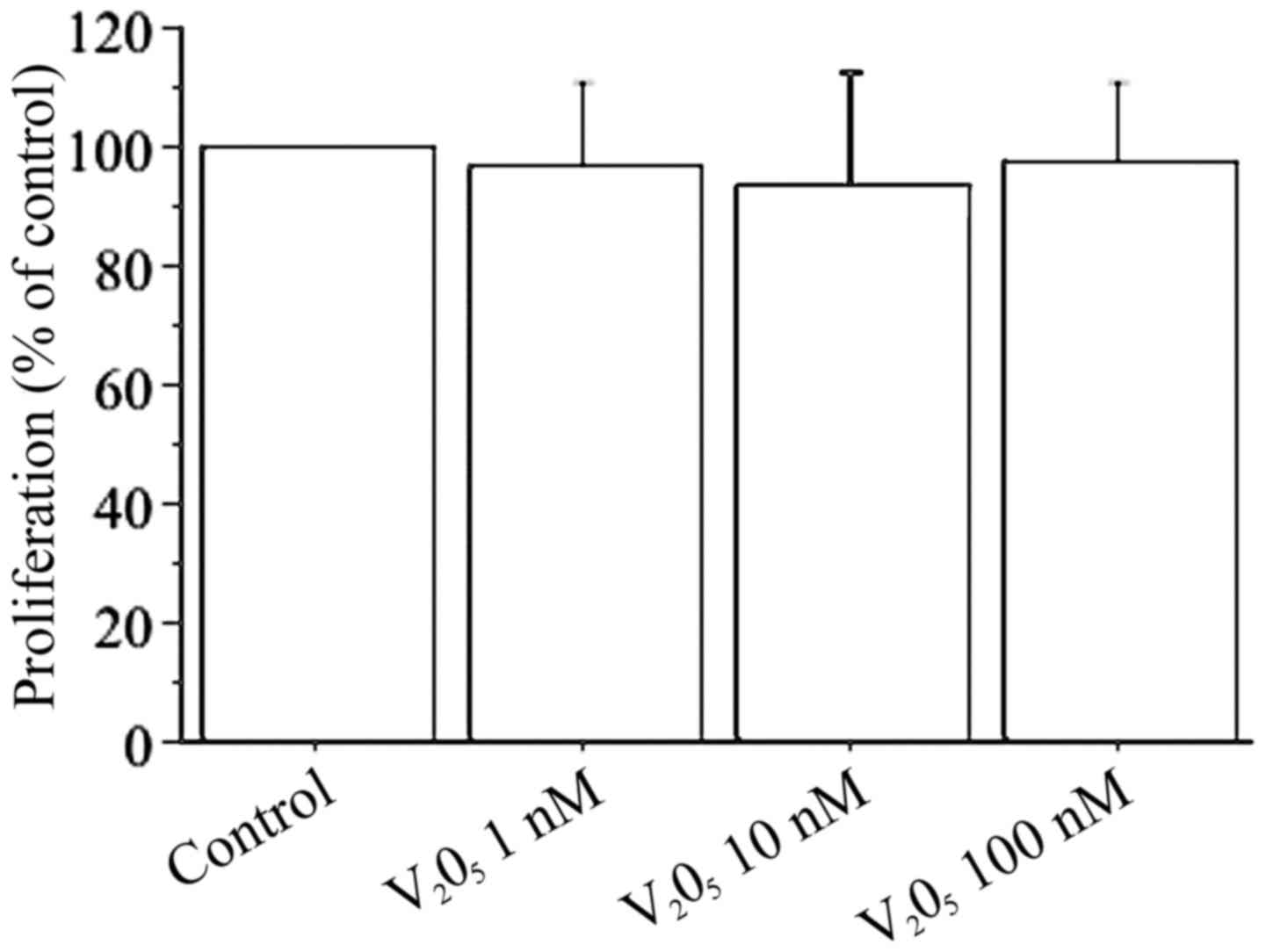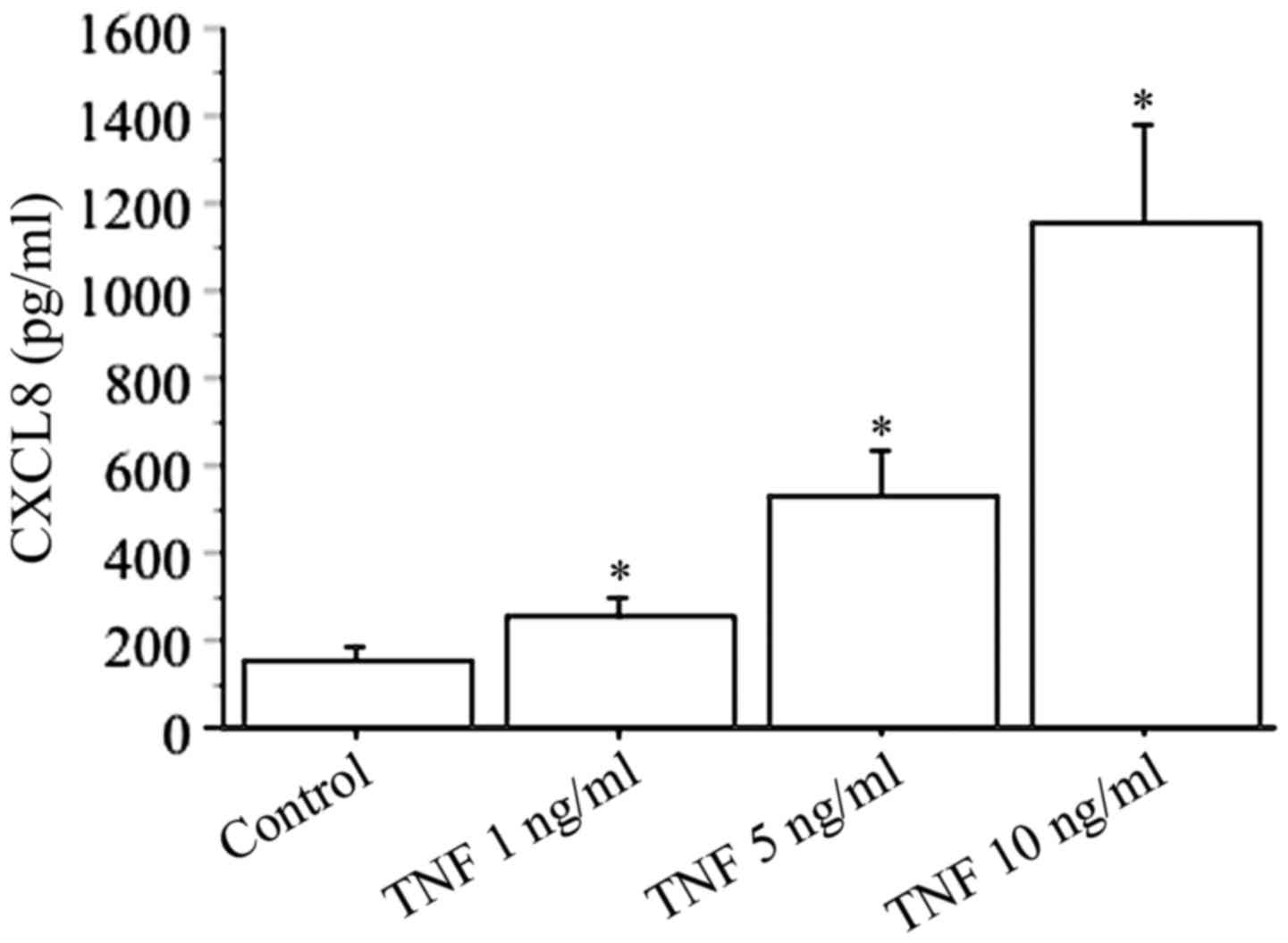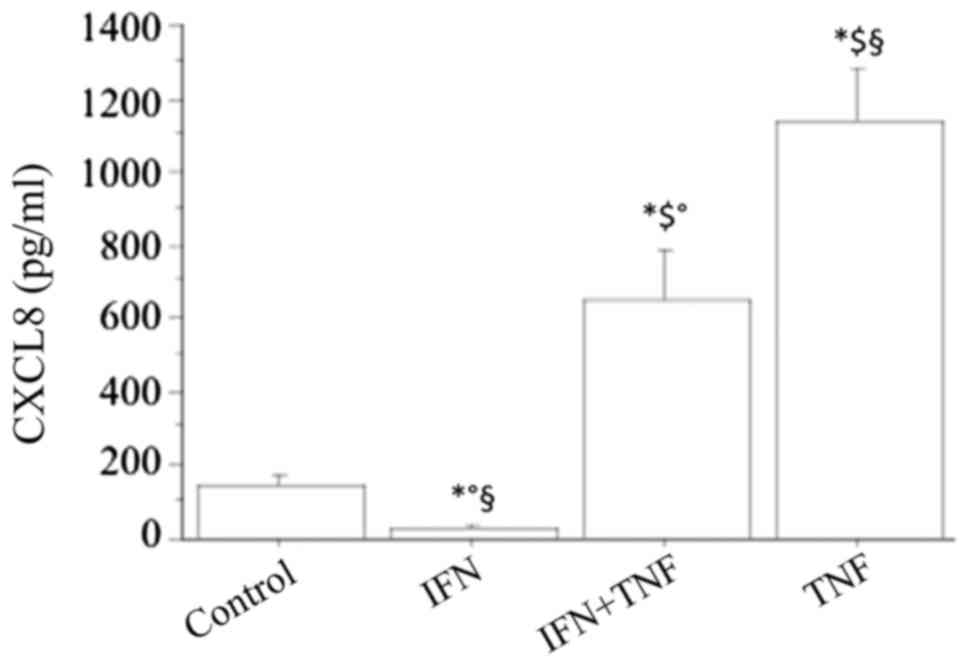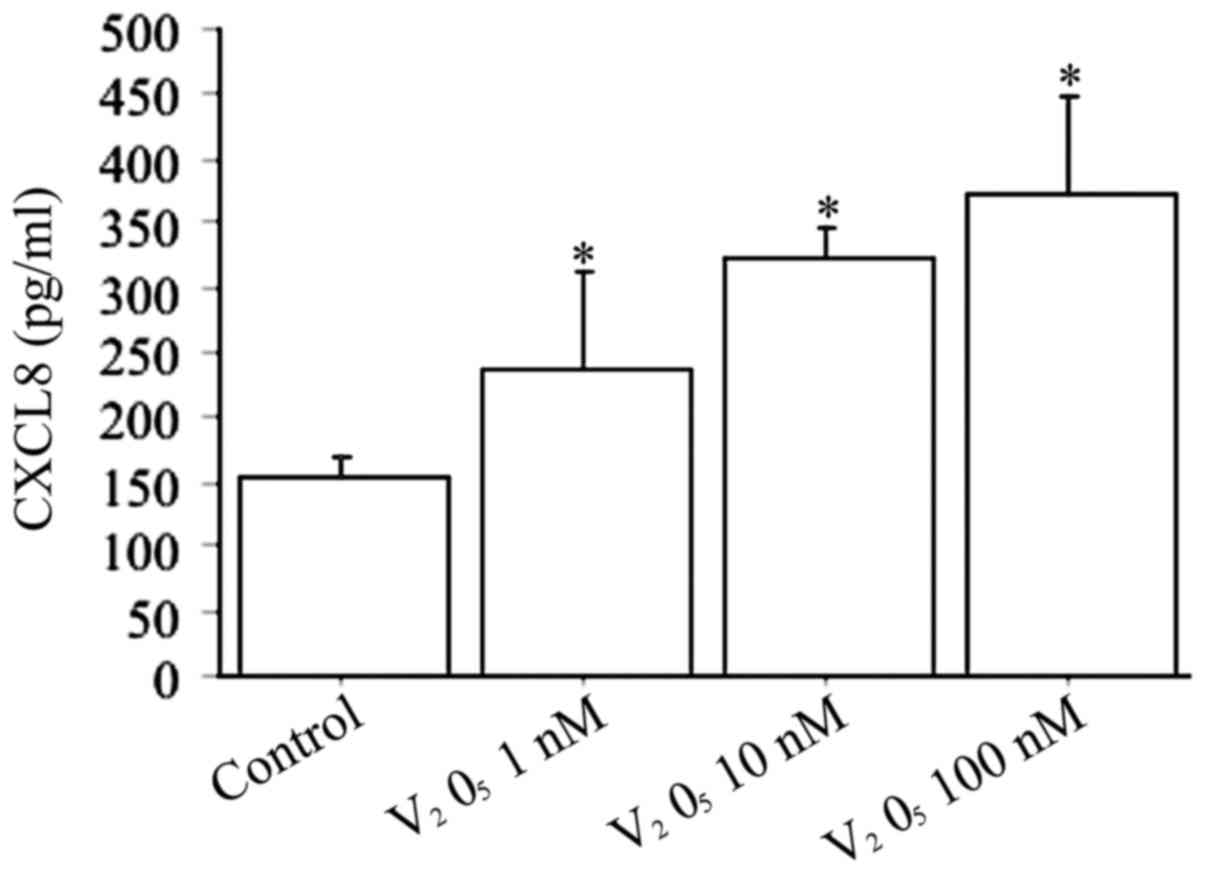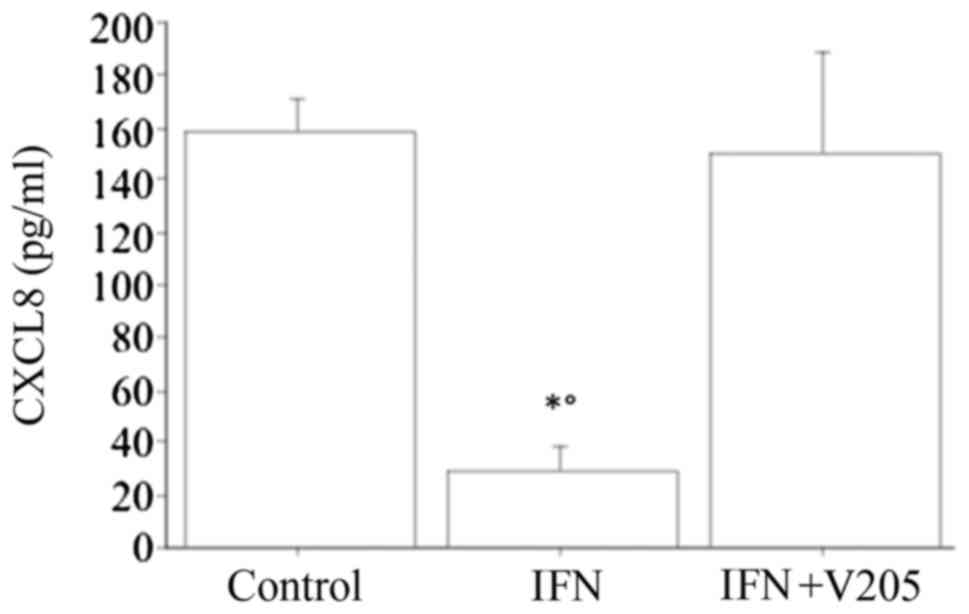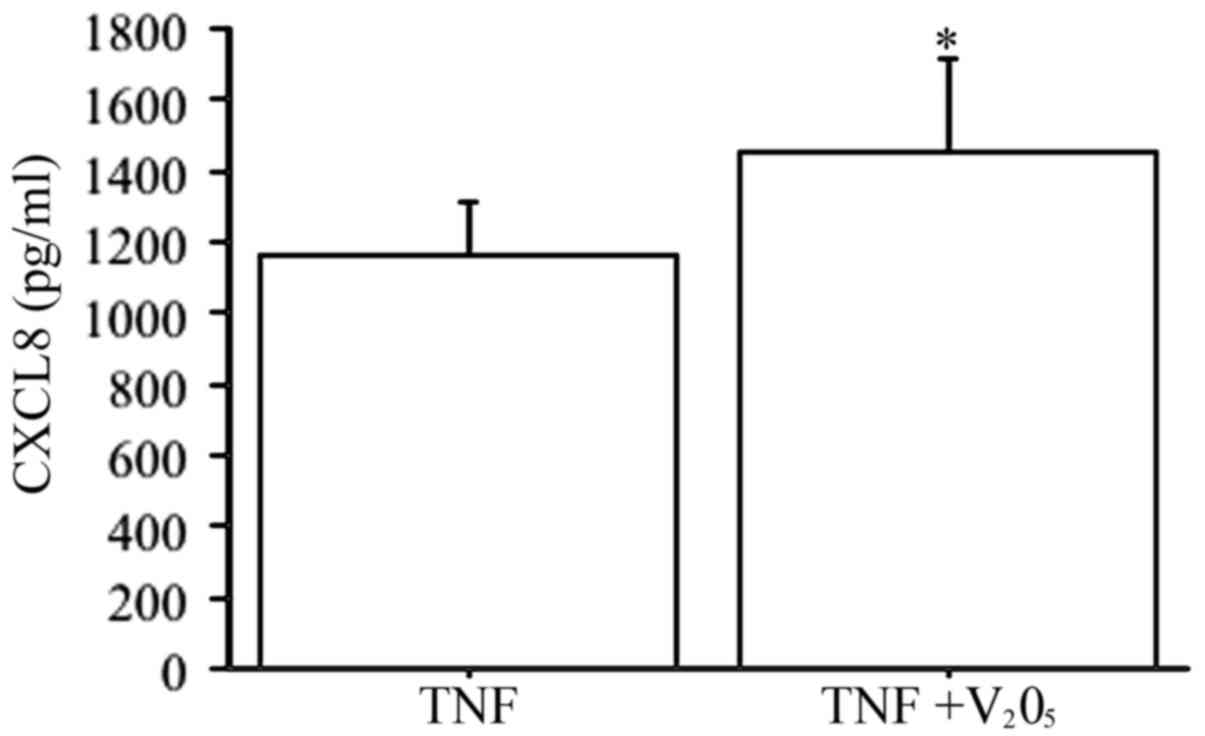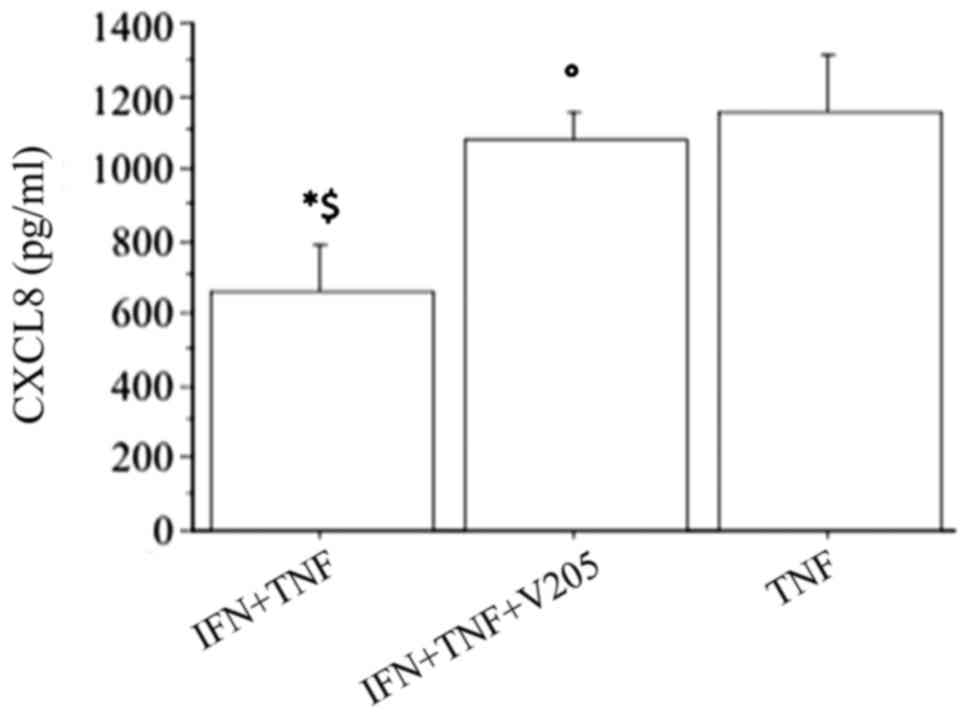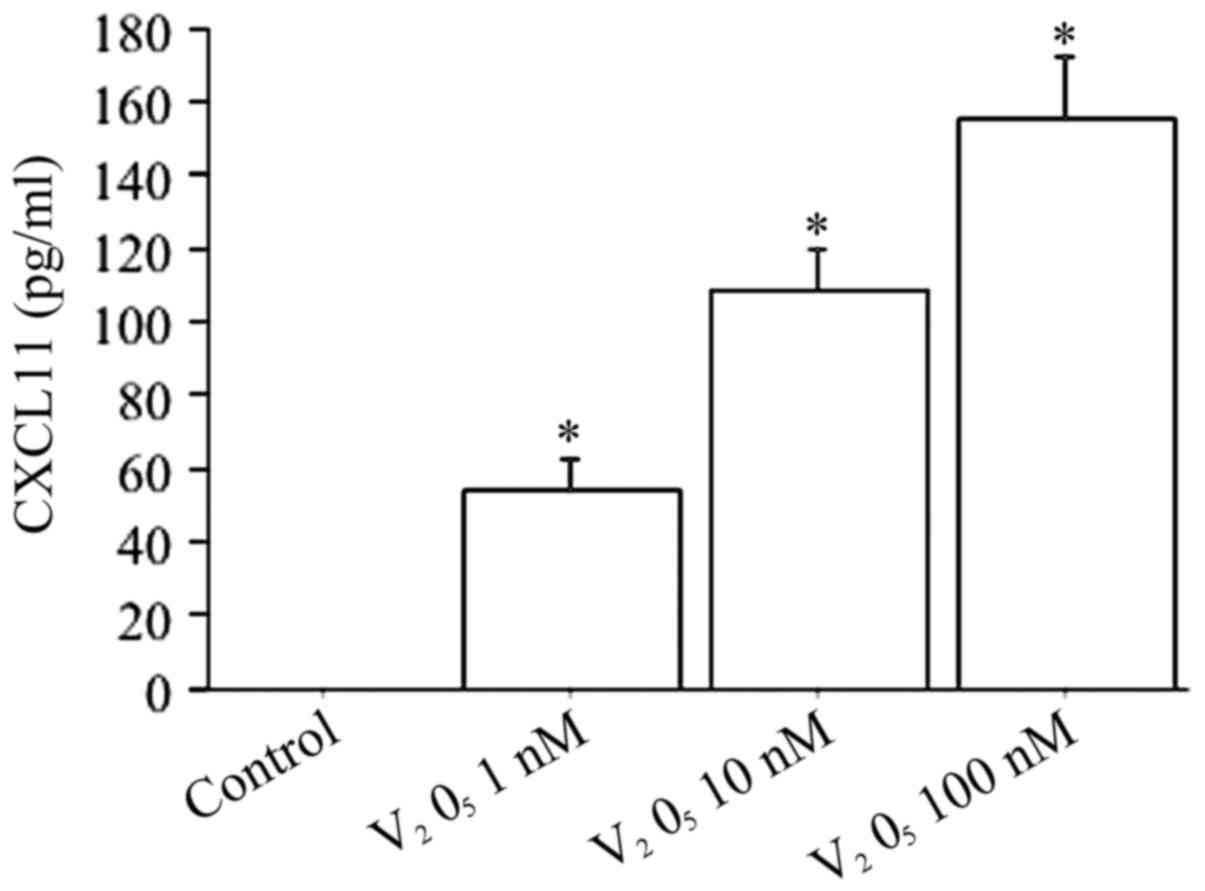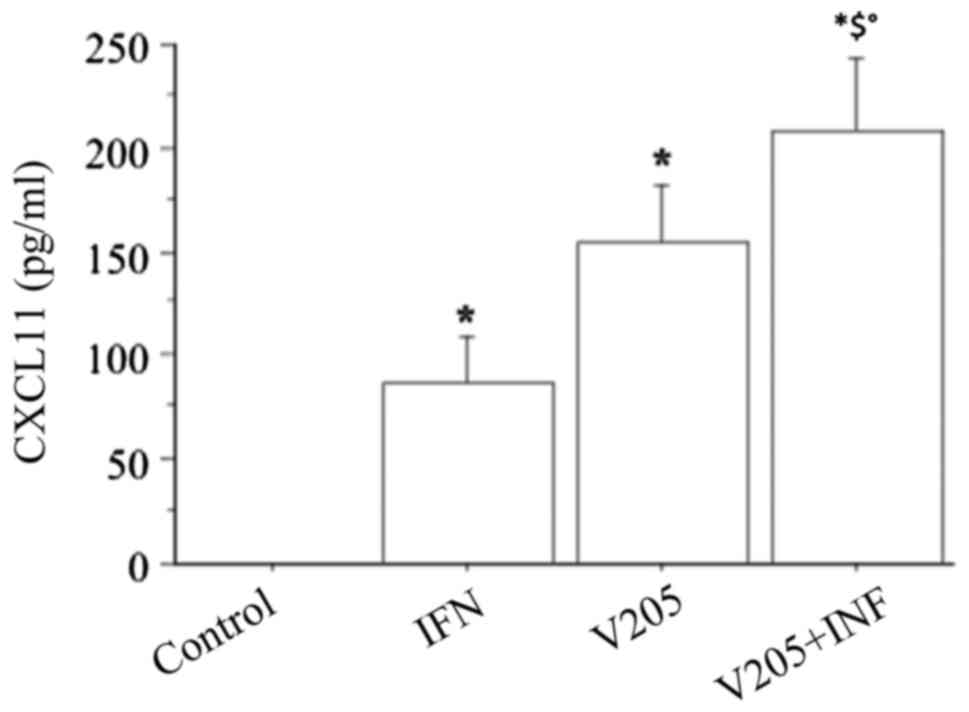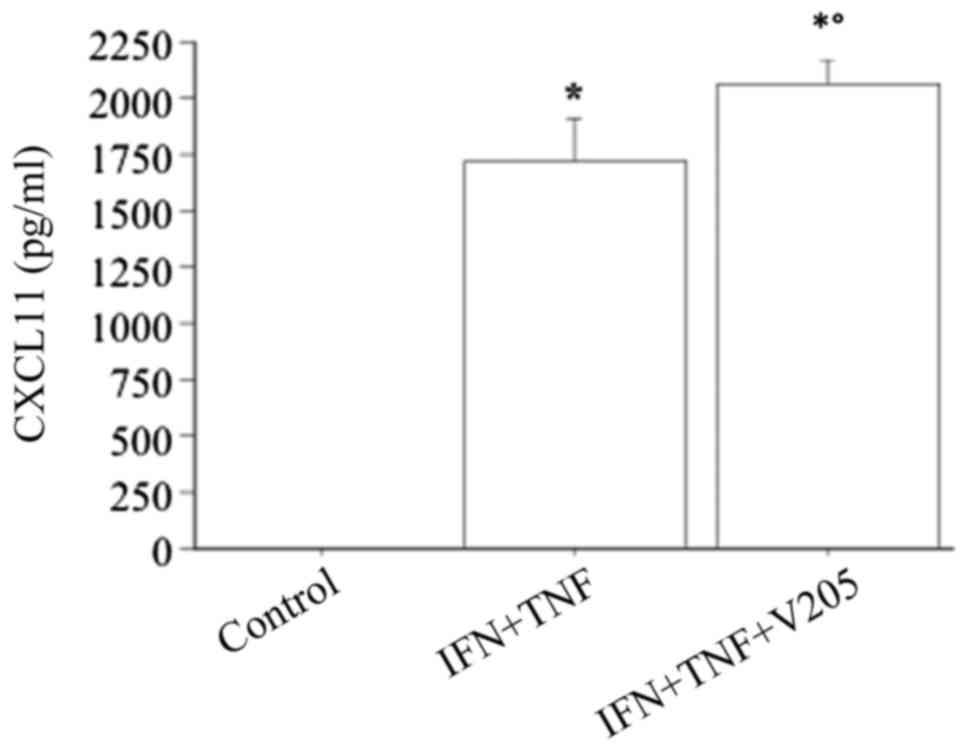CXCL8 and CXCL11 chemokine secretion in dermal fibroblasts is differentially modulated by vanadium pentoxide
- Authors:
- Published online on: June 1, 2018 https://doi.org/10.3892/mmr.2018.9121
- Pages: 1798-1803
Abstract
Introduction
Vanadium is a grey metal that exists in different states of oxidation (ranging from −1 to +5) of which vanadium pentoxide (V2O5) is the most usual form.
All vanadium compounds have been considered toxic. The exposure limit to V2O5 dust and fumes in workplace air (8 h work day/40 h work week) has been fixed by the Occupational Safety and Health Administration in 0.05 and 0.1 mg/m3, respectively (1).
The National Institute for Occupational Safety and Health (NIOSH) sets to 35 mg/m3 the dose of vanadium exposure that may cause seriously health issues up to death (1).
Toxic effects of vanadium are reflected mainly on respiratory system, while the effect on the gastrointestinal system is less relevant because of the minimal gut absorption rate of the substance (2–4). Unfortunately, no sufficient data are available in order to determine the reference range of a subchronic or chronic inhaled dose.
Studies conducted on rat models showed the toxic effects (resulted from an oral, or inhaled, vanadium exposures) on serum parameters (5,6), liver (7), nervous (8) and other tissues development (9).
Vanadium workers (NIOSH 1983) showed an increased prevalence of skin rashes, such as atopic dermatitis.
Until now no in vivo, or in vitro, studies were carried out to evaluate the effect of exposure to vanadium in dermal fibroblasts.
Here, we evaluate the effect of V2O5 on viability and proliferation, and secretion of chemokine (C-X-C motif) ligand (CXCL)8, or CXCL11 [an interferon (IFN)γ dependent chemokine, of the same class of CXCL9, and CXCL10] in dermal human fibroblasts.
Materials and methods
Fibroblast cell cultures
We have obtained fibroblasts from derma of six patients who underwent an operation for thyroid nodular goiter (discard dermal material; all females, age range 57–76 years, euthyroid, without other disorders or diseases, and not treated with any kind of drugs).
Involved subjects gave their informed consent and the study was approved by the University of Pisa (Pisa, Italy) Ethics Committee. Tissue explants were firstly minced and then placed in culture dishes, allowing the fibroblasts proliferation (as previously described) (10). Fibroblasts were propagated in 199 medium [with 20% FBS (Gibco; Thermo Fisher Scientific, Waltham, MA, USA), gentamycin (20 µg/ml), penicillin (100 U/ml)], in a 37°C humidified incubator with 5% CO2; and maintained subsequently in a 199 medium with 10% FBS (and antibiotics) (11). The cells were all used at the 4th passage, and were tested for purity by immunocytochemistry (12).
Proliferation and viability
We have done the WST-1 (Roche Diagnostics, Almere, The Netherlands) assay (that uses 3-[4,5-dimethylthiazol-2-yl]-2,5-diphenyltetrazolium bromide, in the MTT assay) to evaluate cell viability and proliferation (13–16).
Firstly fibroblasts were seeded in each well of 96-well plates at a concentration of 35,000 cells/ml (in a final volume of 100 µl).
Subsequently V2O5 effect on fibroblasts viability and proliferation was determined exposing cells for 24 h with increased concentrations of the compound (1, 10, 100 nM).
Fibroblasts were plated and treated with V2O5 or with its vehicle alone (for 24 h), performing all experiments in triplicate for each cell preparation.
As the cell viability and proliferation WST-1 assay may have limitations on evaluating cellular proliferation (17), fibroblasts proliferation was determined also by cell number counting (13–16).
Chemokine secretion assay and ELISA
To perform the CXCL8 and CXCL11 secretion assays, 30,000 cells/ml were seeded in 96-well plates, in a final volume of 100 µl per well, in growth medium, that was removed after 24 h. After cells were washed in PBS, and incubated (24 h) in phenol red and serum-free medium containing IFNγ (500, 1,000, 5,000, 10,000 IU/ml) and/or 10 ng/ml TNFα (all R&D Systems, Minneapolis, MN, USA), alone or in combination (10). The TNFα concentration to obtain the highest secretion was selected in preliminary experiments. After 1 day the supernatants were collected and then kept frozen at −20°C (until chemokine assay).
We treated fibroblasts, for 24 h, with increasing concentrations of V2O5 (1, 10, 100 nM), in presence/absence of IFNγ (1,000 IU/ml), and/or TNFα (10 ng/ml), in order to evaluate the effect of V2O5 on the chemokine secretion induced by IFNγ.
CXCL8 and CXCL11 concentrations were measured in the supernatants using the ELISA assay. The experiments were carried out three times, for each different cell preparation.
Chemokines levels were measured in culture supernatants, using commercially kits (R&D Systems). The mean minimum detectable dose was 2.7 pg/ml for CXCL8 and 3.2 pg/ml for CXCL11; the intra- and inter-assay coefficients of variation were 3.5 and 6.5% for CXCL8, 4.7 and 8.5% for CXCL11. Quality control pools of low, normal, or high concentration for all parameters were included in each assay.
Statistical analysis
For normally distributed variables values are given in text as mean (±SD), or mean (±SEM) in figures, otherwise as median [and interquartile range]. Mean group values are compared by one-way analysis of variance (ANOVA) for variables normally distributed, or with the Kruskal-Wallis test, or Mann-Whitney U test. Proportions are compared by the Chi-Square. We have used the Bonferroni-Dunn test for post hoc comparison of normally distributed variables.
Results
Cell proliferation of dermal fibroblasts
Cell counting shows that V2O5 (1, 10, 100 nM) does not change viability or proliferation of dermal fibroblasts (Fig. 1). The results of WST-1 assay in dermal fibroblasts with V2O5 (1, 10, 100 nM) confirmed the cell counting data: with V2O5 1 nM it was 99% with respect to the control; with V2O5 10 nM it was 97% with respect to the control; and with V2O5 100 nM it was 98% with respect to the control.
Fibroblast secretion of CXCL8
In basal conditions, the secretion of CXCL8 (range, 51–213 pg/ml) was measured in all preparations of cultured dermal fibroblasts (Fig. 2).
CXCL8 secretion increased in a dose-dependent manner using different concentrations of TNFα (1, 5, 10 ng/ml), with the highest response reached with 10 ng/ml TNFα (basal 156±46 pg/ml vs. TNFα 1154±321 pg/ml; P<0.01) (Fig. 2).
The basal CXCL8 secretion was significantly inhibited by IFNγ in a dose-dependent manner (CXCL8: 84±37, 34±25, pg/ml; respectively, with IFNγ 500 or 1,000 IU/ml; ANOVA, P<0.05), while TNFα alone (10 ng/ml) significantly stimulated the CXCL8 secretion (P<0.01) (Fig. 3). Combining IFNγ with TNFα led to a significant reversal of the stimulating effect of TNFα (TNFα+IFNγ 661±176 pg/ml vs. TNFα 1154±321 pg/ml; P<0.05) (Fig. 3). However, the stimulating effect of TNFα on the secretion of CXCL8 was not completely reversed by IFNγ, because the concentration of this chemokine was still significantly higher than in basal conditions (TNFα+IFNγ vs. basal; P<0.01).
When fibroblasts were treated with increased V2O5 concentrations (1, 10, 100 nM) the CXCL8 release was dose-dependently stimulated (P<0.0001, by ANOVA) (Fig. 4).
When treating dermal fibroblasts with V2O5 (100 nM), together with IFNγ, CXCL8 release was not significantly changed with respect to the basal condition, and IFNγ suppressed the V2O5 stimulating effect, but it stills increased it compared to IFNγ alone (Fig. 5).
V2O5 (100 nM) plus TNFα elicited a synergistic effect on CXCL8 secretion (P<0.0001, by ANOVA), compared to TNFα alone (Fig. 6).
The CXCL8 release synergistically increased (P<0.0001, by ANOVA), when fibroblasts were treated with V2O5 (100 nM) with the combination of IFNγ and TNFα, abolishing the inhibitory effect of IFNγ (Fig. 7).
Fibroblast secretion of CXCL11
CXCL11 release was inducted by IFNγ in a dose-dependent manner (CXCL11: 0, 31±17, 87±35, 123±47, 187±52 pg/ml; respectively, with IFNγ 0, 500, 1,000, 5,000, 10,000 IU/ml; ANOVA, P<0.001).
TNFα alone had no effect (chemokine remaining undetectable), while the combination of IFNγ and TNFα had a significant synergistic effect on the CXCL11 secretion (CXCL11, 1724±252 vs. 87±35 pg/ml with IFNγ alone, ANOVA, P<0.0001).
When fibroblasts were treated with increased V2O5 concentrations (1, 10, 100 nM) the CXCL11 release was dose-dependently stimulated (ANOVA, P<0.0001) (Fig. 8).
CXCL11 release was not significantly changed treating cells with V2O5 (100 nM), together with TNFα, with respect to V2O5 alone (data not shown).
When treating fibroblasts with V2O5 (100 nM), plus IFNγ, CXCL11 release synergistically increased (P<0.0001, by ANOVA), compared to both IFN or V2O5 alone (Fig. 9).
CXCL11 release was synergistically increased (ANOVA, P<0.0001) when fibroblasts were treated with V2O5 (100 nM), together with IFNγ and TNFα stimulation, compared to IFNγ+TNFα (Fig. 10).
Discussion
Our results demonstrate that V2O5 stimulates the secretion of the CXCL8 chemokine, and of the IFNγ dependent chemokine CXCL11, in dermal fibroblasts, without altering their viability and proliferation. Moreover, our study confirms that IFNγ and TNFα stimulated in a different way, the secretion of CXCL8, or CXCL11, chemokines as expected (18). Interestingly, V2O5 can synergize with IFNγ and TNFα, furtherly increasing CXCL11 secretion. In addition, V2O5 combined with TNFα, elicited a synergistic influence on CXCL8 chemokine production, abolishing the inhibitory effect of IFNγ.
These results, on the whole, agreed with the view that V2O5 is able to induce and perpetuate an inflammatory disorder in the dermal tissue inducing inflammatory chemokines secretion (13).
Our findings regarding TNFα, and IFNγ effect in fibroblasts are in line with the results of another study in a different type of cells. In fact, it has been recently investigated if CXCL8 and CXCL10 chemokines secretion by normal human thyrocytes is dependent upon specific proinflammatory stimuli. CXCL8, but not CXCL10 (an IFNγ inducible chemokine, of the same class of CXCL11), was detected in basal conditions. The two chemokines showed differences in their response to proinflammatory cytokines.
Actually, IFNγ induced a significant CXCL10 secretion, not obtained with TNFα; whereas CXCL8 was secreted in response to TNFα, being instead inhibited by IFNγ. The combination of TNFα plus IFNγ synergistically increased the IFNγ-induced CXCL10 secretion, while reversed the TNFα-induced CXCL8 secretion (19).
IFNγ-inducible CXC chemokines can be produced by several types of normal mammalian cells, such as thyrocytes, fibroblasts, colon epithelial cells, islet cells, and others (10,13,14,10). However, these cells are not able to produce the CXC chemokines in basal condition, but only when stimulated by cytokines, such as IFNγ and TNFα, that are released in a T-helper 1 (Th1) type inflammatory site, such as the thyroid at the beginning of Graves' disease, by Th1 activated lymphocytes. It has been suggested that this process can be involved in the initiation and the perpetuation of the inflammation in several autoimmune diseases (10,13,14,10), and considering our results it can be applied to the thyroid, too.
Our findings about vanadium stimulation of chemokines agree with those of other studies conducted in different cell types. V2O5 exposure is a cause of occupational bronchitis; a study evaluated gene expression profiles in human lung fibroblasts (in cultures) after V2O5 exposure with the aim to identify genes that could be implicated in the bronchial inflammation, repair, and fibrosis in the pathogenesis of bronchitis. Among the 10 genes overexpressed by V2O5, also CXCL8, CXCL9 and CXCL10 were induced (26).
Another study reports that fibroblasts have a role in the innate immune response to vanadium-induced oxidative stress through the synthesis of IFNβ and the activation of STAT-1 that cause an increase of CXCL10 levels (27).
Interestingly vanadium can increase chemokine secretion in a dose range, from 1 to 100 nM. It could be observed that normal blood levels of vanadium are ranging from 0.45 to 18.4 nM, and that 100 nM is a dose that might mimick an abnormally high exposure (28). So we could hypothesize that the induction of an inflammatory reaction into the dermal tissue could predispose to the appearance of skin rashes, or atopic dermatitis.
In conclusion our study shows that V2O5 can induce CXCL8, and CXCL11 chemokines secretion into the dermal fibroblasts. Interestingly, V2O5 synergistically increased the effect of the IFNγ on CXCL11 secretion. Moreover, V2O5 synergistically increased the effect of the TNFα on CXCL8 secretion, abolishing the inhibitory effect of IFNγ. Overall CXCL8, and CXCL11 chemokines induction by V2O5 could lead to the appearance and perpetuation of an inflammatory reaction into the dermal tissue. Further studies are needed to evaluate dermal integrity, and manifestations in subjects occupationally exposed, or living in polluted areas.
Acknowledgements
Not applicable.
Funding
No funding was received.
Availability of data and materials
All data generated or analyzed during this study are included in this published article.
Authors' contributions
PF, SB, AA and SMF made substantial contributions to the conception and design of the study and to the acquisition of data. All authors analyzed the data. PF, SB, AA and SMF drafted the manuscript. AA revised the manuscript. All authors read and approved the manuscript and agree to be accountable for all aspects of the research in ensuring that the accuracy or integrity of any part of the study are appropriately investigated and resolved. All authors read and approved the final manuscript.
Ethics approval and consent to participate
Written informed consent was obtained from all study participants and the study was approved by the University of Pisa Ethics Committee.
Consent for publication
Written informed consent was obtained from all participants for the publication of their data.
Competing interests
The authors declare that they have no competing interests.
References
|
Occupational Safety and Health Administration: Occupational Safety and Health Guidelines for Vanadium Pentoxide. https://www.osha.gov/SLTC/metalsheavy/vanadium.htmlOctober 29–2017 | |
|
Sax NI: Dangerous Properties of Industrial Materials. 6th edition. Van Nostrand Reinhold Company; New York, NY: pp. 2717–2720. 1984 | |
|
Ress NB, Chou BJ, Renne RA, Dill JA, Miller RA, Roycroft JH, Hailey JR, Haseman JK and Bucher JR: Carcinogenicity of inhaled vanadium pentoxide in F344/N rats and B6C3F1 mice. Toxicol Sci. 74:287–296. 2003. View Article : Google Scholar : PubMed/NCBI | |
|
Wörle-Knirsch JM, Kern K, Schleh C, Adelhelm C, Feldmann C and Krug HF: Nanoparticulate vanadium oxide potentiated vanadium toxicity in human lung cells. Environ Sci Technol. 41:331–336. 2007. View Article : Google Scholar : PubMed/NCBI | |
|
Scibior A, Zaporowska H and Ostrowski J: Selected haematological and biochemical parameters of blood in rats after subchronic administration of vanadium and/or magnesium in drinking water. Arch Environ Contam Toxicol. 51:287–295. 2006. View Article : Google Scholar : PubMed/NCBI | |
|
González-Villalva A, Fortoul TI, Avila-Costa MR, Piñón-Zarate G, Rodriguez-Laraa V, Martínez-Levy G, Rojas-Lemus M, Bizarro-Nevarez P, Díaz-Bech P, Mussali-Galante P and Colin-Barenque L: Thrombocytosis induced in mice after subacute and subchronic V2O5 inhalation. Toxicol Ind Health. 22:113–116. 2006. View Article : Google Scholar : PubMed/NCBI | |
|
Kobayashi K, Himeno S, Satoh M, Kuroda J, Shibata N, Seko Y and Hasegawa T: Pentavalent vanadium induces hepatic metallothionein through interleukin-6-dependent and -independent mechanisms. Toxicology. 228:162–170. 2006. View Article : Google Scholar : PubMed/NCBI | |
|
Soazo M and Garcia GB: Vanadium exposure through lactation produces behavioral alterations and CNS myelin deficit in neonatal rats. Neurotoxicol Teratol. 29:503–510. 2007. View Article : Google Scholar : PubMed/NCBI | |
|
Barceloux DG: Vanadium. J Toxicol Clin Toxicol. 37:265–278. 1999. View Article : Google Scholar : PubMed/NCBI | |
|
Antonelli A, Ferri C, Fallahi P, Ferrari SM, Frascerra S, Sebastiani M, Franzoni F, Galetta F and Ferrannini E: High values of CXCL10 serum levels in patients with hepatitis C associated mixed cryoglobulinemia in presence or absence of autoimmune thyroiditis. Cytokine. 42:137–143. 2008. View Article : Google Scholar : PubMed/NCBI | |
|
Valyasevi RW, Harteneck DA, Dutton CM and Bahn RS: Stimulation of adipogenesis, peroxisome proliferator-activated receptor-gamma (PPARgamma), and thyrotropin receptor by PPARgamma agonist in human orbital preadipocyte fibroblasts. J Clin Endocrinol Metab. 87:2352–2358. 2002. View Article : Google Scholar : PubMed/NCBI | |
|
Wang L, Luo J and He S: Induction of MMP-9 release from human dermal fibroblasts by thrombin: Involvement of JAK/STAT3 signaling pathway in MMP-9 release. BMC Cell Biol. 8:142007. View Article : Google Scholar : PubMed/NCBI | |
|
Antonelli A, Rotondi M, Fallahi P, Romagnani P, Ferrari SM, Buonamano A, Ferrannini E and Serio M: High levels of circulating CXC chemokine ligand 10 are associated with chronic autoimmune thyroiditis and hypothyroidism. J Clin Endocrinol Metab. 89:5496–5499. 2004. View Article : Google Scholar : PubMed/NCBI | |
|
Kemp EH, Metcalfe RA, Smith KA, Woodroofe MN, Watson PF and Weetman AP: Detection and localization of chemokine gene expression in autoimmune thyroid disease. Clin Endocrinol (Oxf). 59:207–213. 2003. View Article : Google Scholar : PubMed/NCBI | |
|
Antonelli A, Bocci G, La Motta C, Ferrari SM, Fallahi P, Fioravanti A, Sartini S, Minuto M, Piaggi S, Corti A, et al: Novel pyrazolopyrimidine derivatives as tyrosine kinase inhibitors with antitumoral activity in vitro and in vivo in papillary dedifferentiated thyroid cancer. J Clin Endocrinol Metab. 96:E288–E296. 2011. View Article : Google Scholar : PubMed/NCBI | |
|
Antonelli A, Ferrari SM, Fallahi P, Berti P, Materazzi G, Barani L, Marchetti I, Ferrannini E and Miccoli P: Primary cell cultures from anaplastic thyroid cancer obtained by fine-needle aspiration used for chemosensitivity tests. Clin Endocrinol (Oxf). 69:148–152. 2008. View Article : Google Scholar : PubMed/NCBI | |
|
Quent VM, Loessner D, Friis T, Reichert JC and Hutmacher DW: Discrepancies between metabolic activity and DNA content as tool to assess cell proliferation in cancer research. J Cell Mol Med. 14:1003–1013. 2010. View Article : Google Scholar : PubMed/NCBI | |
|
Antonelli A, Ferrari SM, Fallahi P, Frascerra S, Santini E, Franceschini SS and Ferrannini E: Monokine induced by interferon gamma (IFNgamma) (CXCL9) and IFNgamma inducible T-cell alpha-chemoattractant (CXCL11) involvement in Graves' disease and ophthalmopathy: Modulation by peroxisome proliferator-activated receptor-gamma agonists. J Clin Endocrinol Metab. 94:1803–1809. 2009. View Article : Google Scholar : PubMed/NCBI | |
|
Rotondi M, Coperchini F, Pignatti P, Sideri R, Groppelli G, Leporati P, La Manna L, Magri F, Mariotti S and Chiovato L: Interferon-γ and tumor necrosis factor-α sustain secretion of specific CXC chemokines in human thyrocytes: A first step toward a differentiation between autoimmune and tumor-related inflammation? J Clin Endocrinol Metab. 98:308–313. 2013. View Article : Google Scholar : PubMed/NCBI | |
|
Antonelli A, Ferrari SM, Frascerra S, Pupilli C, Mancusi C, Metelli MR, Orlando C, Ferrannini E and Fallahi P: CXCL9 and CXCL11 chemokines modulation by peroxisome proliferator-activated receptor-alpha agonists secretion in Graves' and normal thyrocytes. J Clin Endocrinol Metab. 95:E413–E420. 2010. View Article : Google Scholar : PubMed/NCBI | |
|
Garcià-Lòpez MA, Sancho D, Sànchez-Madrid F and Marazuela M: Thyrocytes from autoimmune thyroid disorders produce the chemokines IP-10 and Mig and attract CXCR3+ lymphocytes. J Clin Endocrinol Metab. 86:5008–5016. 2001. View Article : Google Scholar : PubMed/NCBI | |
|
Antonelli A, Ferrari SM, Corrado A, Ferrannini E and Fallahi P: CXCR3, CXCL10 and type 1 diabetes. Cytokine Growth Factor Rev. 25:57–65. 2014. View Article : Google Scholar : PubMed/NCBI | |
|
Antonelli A, Ferrari SM, Giuggioli D, Ferrannini E, Ferri C and Fallahi P: Chemokine (C-X-C motif) ligand (CXCL)10 in autoimmune diseases. Autoimmun Rev. 13:272–280. 2014. View Article : Google Scholar : PubMed/NCBI | |
|
Antonelli A, Fallahi P, Delle Sedie A, Ferrari SM, Maccheroni M, Bombardieri S, Riente L and Ferrannini E: High values of Th1 (CXCL10) and Th2 (CCL2) chemokines in patients with psoriatic arthtritis. Clin Exp Rheumatol. 27:22–27. 2009.PubMed/NCBI | |
|
Fallahi P, Ferrari SM, Ruffilli I, Elia G, Biricotti M, Vita R, Benvenga S and Antonelli A: The association of other autoimmune diseases in patients with autoimmune thyroiditis: Review of the literature and report of a large series of patients. Autoimmun Rev. 15:1125–1128. 2016. View Article : Google Scholar : PubMed/NCBI | |
|
Ingram JL, Antao-Menezes A, Turpin EA, Wallace DG, Mangum JB, Pluta LJ, Thomas RS and Bonner JC: Genomic analysis of human lung fibroblasts exposed to vanadium pentoxide to identify candidate genes for occupational bronchitis. Respir Res. 8:342007. View Article : Google Scholar : PubMed/NCBI | |
|
Antao-Menezes A, Turpin EA, Bost PC, Ryman-Rasmussen JP and Bonner JC: STAT-1 signaling in human lung fibroblasts is induced by vanadium pentoxide through an IFN-beta autocrine loop. J Immunol. 180:4200–4207. 2008. View Article : Google Scholar : PubMed/NCBI | |
|
Sabbioni E, Kuèera J, Pietra R and Vesterberg O: A critical review on normal concentrations of vanadium in human blood, serum, and urine. Sci Total Environ. 188:49–58. 1996. View Article : Google Scholar : PubMed/NCBI |



